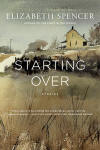Starting Over
Ninety-two-year-old Elizabeth Spencer, with fifteen works published over the course of seven decades, is known as the “Grand Dame” of Southern literature—yet she addresses contemporary family problems as sharply as any younger author. Her best-known work is the 1960 novella Light in the Piazza, as it was made into a Broadway show. It’s been more than a decade since her last book, and her new short story collection, Starting Over, is worth the wait.
Ninety-two-year-old Elizabeth Spencer, with fifteen works published over the course of seven decades, is known as the “Grand Dame” of Southern literature—yet she addresses contemporary family problems as sharply as any younger author. Her best-known work is the 1960 novella Light in the Piazza, as it was made into a Broadway show. It’s been more than a decade since her last book, and her new short story collection, Starting Over, is worth the wait.
These nine stories are written in unadorned prose, at times conversational, as with the expression, “he went all the way around elbow to thumb.” Most of the stories have to do with children coming back to visit their parents, children often from a previous marriage, who disrupt the present marriage. Or the child, now adult, is visiting and confronting memories or even illusions inspired by the past.
For instance, “Return Trip” renews a marriage from the threat of an unexpected visit from an old beau and the visit of their son, who looks like the beau. And still the wife finds pleasure in the past: “It was then she heard the Mississippi voices for the first time. She knew each one for who it was, though they had died years ago or hadn’t been seen for ages. . . . She knew she would hear them always, from now on.”
The past plays a big part in these stories—in “Boy in the Tree” it is the adult who visits his mother. His illusions, unexpectedly, are less real than his mother’s, though again, inspired by the past, they give him pleasure: “He watched the line of the woods where the property ended. There the girl with silver hair would appear, the tiger walking beside her. He was happy and he did not see why not.”
This is tied to other insights about happiness:
In routine lies contentment . . .
He wondered if happiness always came in packages, wrapped up in time. Try to extend the time, and the package got stubborn. Not wanting to be opened, it just sat and remained the same. You couldn’t get back in it because time had carried you elsewhere.
Often the endings, seemingly happy, are tinged with sadness. Yet they are satisfying, because the characters are starting over, reconciled to their lot, having learned or benefited by the visits. “Sightings,” one of the most moving stories, has to do with a reconciliation of father and visiting daughter. She had, unintentionally, partially blinded him when she was a child, and the father hadn’t fought for custody of her. But they become a renewed family at the end, via finding the father’s dog.
“Blackie” (the name of a dog) is another dog story with a similar reconciliation at the end, yet different from “Sightings.” Blackie is a retriever of objects and at the end retrieves a divorced woman’s son, who reveals horrible truths about this remarried woman’s stepchildren and her father-in-law. However, the woman loves her new family and is willing to sacrifice her son to remain with the people that depends on her. Love is defined realistically:
“I don’t know if anybody can love equally. . . . I love just the way it is.”
That was the way she felt too. Day followed day in what you might call harmony. That was to say that expected things happened as expected.
So she makes peace with her second husband, which is possible from what she has learned in her first marriage: “‘Oh, I’m still here. Honest ones have to stick together.’ She smiled encouragement, knowing they had entered a new chapter. She had had, after all, so much practice.”
The last story, for me the best. “The Wedding Visitor” has a nephew going back to the family home for his cousin’s marriage. This story shows Spencer’s approach of telling sparsely what happens, with much left off-stage. From previously feeling on the outs with his uncle, this nephew turns out to save the day and is rewarded by his uncle. He has found a father and now realizes what he came for.
Spencer deals with unstable situations that become stable at the end. Her style includes occasional deliberate ambiguity suggestive of the lack of stability in life’s major turns. For instance, “they went out together” could mean a date or just exiting the building.
Many of Spencer’s stories deal with divorce. They reveal truths about that “wobbly” situation, as it’s referred to in “Rising Tide”: “There was a thin line of small quarrels between them, sometimes apt to go on indefinitely; it often vanished altogether, only to return. . . . Changes often took place when other scenes and people took over.” And the story “Sightings” notes: “What is separation, together or apart, but one long silence?”
Wisdom, they say, comes with age. It certainly does with Spencer, and her readers are the beneficiaries.





